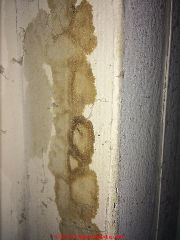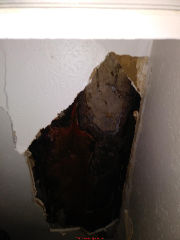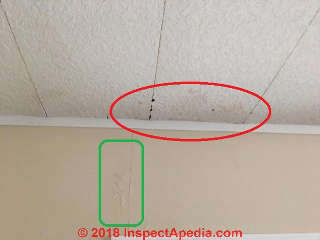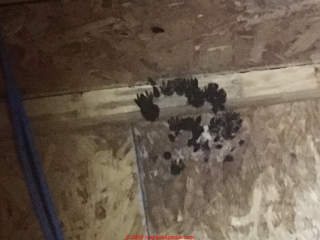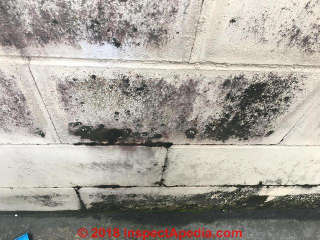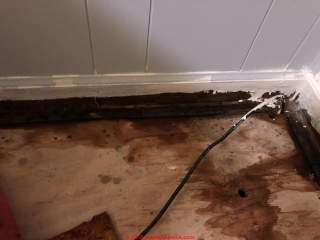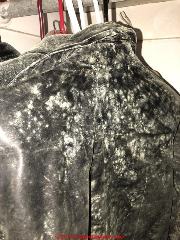 Mold Recognition FAQs-3
Mold Recognition FAQs-3
Mold growth questions & answers
- POST a QUESTION or COMMENT about what black mold, "toxic black mold" or plain cosmetic mold in buildings
FAQs on how to recognize mold contamination in buildings:
Mold recognition FAQs and references to an online reference photo library of various kinds and colors of mold found in buildings.
These pictures of mold on building surfaces help you recognize mold in buildings and also heo you to recognize stuff that is not mold and does not need to be tested.
InspectAPedia tolerates no conflicts of interest. We have no relationship with advertisers, products, or services discussed at this website.
FAQs on Recognizing & Taking Action on Indoor Mold Contamination
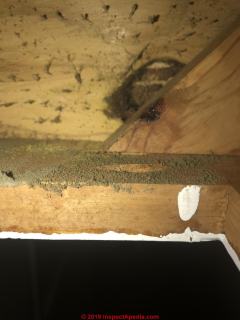 These questions & answers about identifying mold or recognizing mold on various building surfaces and materials were posted originally at MOLD APPEARANCE - WHAT MOLD LOOKS LIKE - be sure to review that article.
These questions & answers about identifying mold or recognizing mold on various building surfaces and materials were posted originally at MOLD APPEARANCE - WHAT MOLD LOOKS LIKE - be sure to review that article.
[Click to enlarge any image]
On 2020-07-15 by anon - The mold on the sheet made me freak out about the damp clothes in the other basket.
Thank you for the info. The clothes in question were damp as they had just come out the wash, but they got dropped on the floor prior to drying/on the way to the line. Me being OCD me, picked them up and threw them back in the laundry basket (one with mesh/open sides and no lid) and thought nothing more of it until I found the moldy sheet and towel in our laundry basket (these were dirty/not out the wash like the clothes and were in a separate laundry basket, a closed side on with lid).
The mold on the sheet made me freak out about the damp clothes in the other basket.
Thus, with regards to mold removal, e do not have a mold problem in our home, it is from a dirty sheet and towel (the joys of kids spilling things) and potentially freshly washed clothes that were dropped on the floor and left damp.
As I said, the clothes were there for about 1 week, I could not see or smell any mold on them before putting them back in the wash, thus it is quite likely there was no mold to begin with. I just needed so confirmation and reassurance from someone who knows/understands mold, so that I can be sure that "IF" there was any mold to begin with, would the 60 degree C and 95 degree C wash have done the job at getting rid of it. Failing that, what would get rid of it, hence the vinegar question, due to this appearing to be a popular one spreading about the internet.
Is heat a way of ridding mold?
Apologies for going on, I realise it is most likely that the mold on the clothes is just being made up by my OCD, since I did not see or smell any in the first place. But it is also useful to know these things for future reference and use.
I really appreciate your info/replies.
Thank you
On 2020-07-14 - by (mod) -
Abon
Vinegar is a good general-purpose disinfectant and it can kill some portion of mold spores on a Surface although it probably won't kill all of them.
However there's a fundamental error in even thinking about using vinegar to kill mold which is that killing mold is not the correct object. The correct object is to remove the mold and find and fix the reason that it grew where did.
I don't like those killing mold and not kill all of the Bold but depending on the mold Jenner and species you may be leaving highly toxic particles in the environment. A dead molds for may not propagate but it may still be toxic. Remove it
On 2020-07-13 by anon
Ok, thank you.
One last thing, can you confirm/do you know, if white vinegar kills mold?
On 2020-07-13 - by (mod) -
I'm sure that you can understand that no one, based only on text posted and text conversation is going to bet your health and money on a complete presumed diagnosis of what's going on in your home or in the clothing worn by occupants in the hole. In general clothes don't smell moldy then they're not. My prior advice is the best that I could think of.
On 2020-07-13 by anon
apologies. I suffer from contamination OCD, thus was very concerned that I had left some damp baby/children clothes in the hamper for about 1 week. I could not see any old or smell any on the clothes, even before the 60 degree C wash, but was just after some reassurance that if it cant be seen or smelt, before or after washing then no mold is present and it is safe for baby/child to wear.
The sheet and towel, however, had very visible mold on. They were left damp for 2 weeks. It is due to the visible mold on the sheet/towel that got me worried about the baby/child clothing. Hence wanted to try and find out if the baby/child clothing was safe or not, when there was no visible mold or smell before and after washing.
On 2020-07-13 - by (mod) -
Anon I cannot get more detailed or specific on this question as we have not a shred of objective data.
Your choices are to use the clothes, clean them repeatedly, or toss them out. The cost of testing is in my opinion not justified and might exceed the value of the clothing.
On 2020-07-13 by anon
sorry, me again. Would the same be applicable to baby and childrens clothes? If they have been washed at 60 degrees C and there is no visible mold or smell, are they safe for baby and child to wear?
Great, thanks.
On 2020-07-12 - by (mod) -
If there is no visible mold and no moldy odor you should be ok
On 2020-07-12 by anon
I have previously run them through on a 60 degree C wash earlier, there does not appear to be any visible mold left on them, and they do not smell moldy/musty. Would they be safe to use now? Will this have been enough to kill/get rid of the mold? Or could it still be there but not visible to naked eye and I need to run them with bleach?
On 2020-07-12 19:41:41.686496 - by (mod) -
Just run an ordinary hot wash cycle with a dose of bleach. You may need to repeat the process.
On 2020-07-12 16:28:45.687457 by anon
Would a 60 degrees C wash in a washing machine rid clothing of minor mold? In terms of "how minor" eg: a damp sheet or towel which was left in a laundry hamper for a week or two, so a small patch of mold, about 1ft square, mostly black, dark green with a few odd specks/splodges of pink. Would this be ok in a washing machine? Would it wash out and make the sheet and towel safe to use again? If a 60 Degree C wash is not sufficient, would a 95 degree C work and make them safe to use?
On 2019-08-14 by (mod) - thick green mold under the kitchen counter
Lin that's a thick mold contamination, perhaps a species of Aspergillus (though there are other green moulds common in that location such as Trichoderma).
You should avoid breathing those spores as they can be harmful.
If I were cleaning up this mold, because it's easily airborne, I'd wear a HEPA respirator, eye protection, etc. and I'd be sure, after cleanup, to thoroughly ventilate the room with fresh air.
Wet the area carefully using a household cleaner, remove the mold, fix the leak that caused it.
DO NOT run a conventional home vacuum cleaner as you'll just increase the airborne mold level.
On 2019-08-14 by Lin
I found this under the kitchen counter where the drawer pulls out. It smells rank and I thought it was dust bunnies, but it has very uniform round bits. Anyone?
On 2019-08-10 by (mod) -
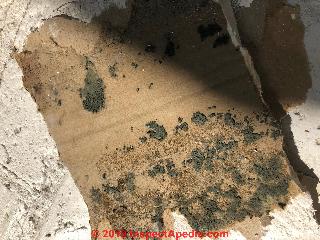 Tim:
Tim:
Thanks for the question and photo.
1. No one can for-sure identify your mold from the photo alone, though common molds of that appearance and in that location might be a species of Aspergillus or a Trichoderma - it's greenish so I rule out Stemonitis that otherwise can look like that.
2. Worry about "black mold" is a terrible dis-service done to the public by some writers and reporters. To say that "black mold" is the only or even most-harmful mold in buildings is simply dead wrong. Harmful mold may be of any color or texture.
3. We don't need to know the genera/species of this mold to know what to do: the species won't change the cleanup procedure one bit.
4. You'll need to follow the water, remove all drywall that was ever wet, clean the exposed surfaces, fix the leak, repair the building.
IF the total area of contiguous mold is 30 sqft or more then professional remediation is probably in order.
On 2019-08-09 by Tim
Hey guys. I had an AC issue that led to water flowing down a wall and into the crawlspace. It came to my attention when I started to notice a smell in the wall that I would have associated with algae in a creek. Even weeks after the leak has been fixed.
No one else could smell is and there were no visible signs of mold. I finally cut open the drywall from floor to ceiling and found this growth on the inside surface. It's dark green and very powdery like a fine dust. I've read that black mold has a slime coating on it.
Hoping it's not that, but I'm having trouble finding photos of any mold that look like this. Hoped I could get some help identifying it here. Thanks
On 2019-08-09 by (mod) - conditions affecting mold genera/species & color on various building materials
Thanks for the opinon Anon.
I agree that a variety of conditions affect WHICH mold genera/species grows in a building - on what material it's growing and thus its food source,
I'd also agree that the toxicity of even the very same mold genera/species mold, mycotoxins, or mvocs can vary depending on the food source, and also on moisture levels and other factors
However the principal source of difference in the COLOR of a specific mold colony is the mold genera/species.
Food source does not change the color of a specific mold genera/species.
Food source does, however, along with moisture level, change which mold genera/species is most likely to be present in that area.
Our article series includes photos of a single area of moldy drywall in which one can find FOUR different mold genera/species on the same wall area, at differing heights from the floor. The ONLY difference that determined these differences was the moisture level in the drywall. (Wet floor: higher from floor level meant less water in the drywall).
Color alone is never enough to speciate a mold, but it is among the identifying factors along with the microscopic features one can examine.
Finally you are dead right and I encourage other readers to note that it's simply wrong to claim that all "black mold" is Stachybotrys chararum (your "stachy),
and equally mistaken to claim that all black mold is toxic or harmful
and equally mistaken to think that only black or dark colored molds are the harmful ones.
In fact Stachybotrys chartarum is a large sticky spore, not easily airborne, not breathed deep into the lungs; and while that spore can be quite harmful, in buildings where conditions have produced S. chartarum (such as on wet drywall), unless the mold "inspector" is ignorant or blind, she will find several other mold genera/species growing as well (it is very rare for there to be only one mold genera/species present).
Among those, the most common and often more dangerous molds are species of Aspergillus or Penicillium, ubiquitous, various colors, very small spores, easily airborne, traveling throughout a building, and breathed deeply into the lung - a source, for example of a troublesome illness that's hard to cure: Aspergillosis.
The "black mold" fear wide in the public mind is a dis-service of some news articles, in my opinion exacerbated by having been leapt upon by the mold-is-gold industry.
In most building mold contamination situations the genera/species of mold is irrelevant: it doesn't change the required procedure one bit:
Find the mold
Remove it
FIx its cause
On 2019-08-09 by Anonymous
The color is dictated by the food source. That’s like saying all black mold is stachy.
On 2019-08-09 by Jim - Mold would need a food source to grow in addition to the humidity (moisture)
@Lauren Craven,
Mold would need a food source to grow in addition to the humidity (moisture). Depending on the ductwork, if you have a newer home the chances of it having enough organic material to actively grow in a duct is rare.
If it is an old interior lined duct, then maybe. Mold is all around you. It’s in the ductwork, and its on your clothes. It follows you when you walk through your front door. Spores are everywhere!
When you find active growth you clean it or remove the material.
On 2019-06-11 by (mod) -
Might want to pull that baseboard off if you think it's moldy. Look on the bottom Edge in the back side for mold growth.
On 2019-06-10 by (mod) -
Ken just click the Add Image button and select the photo on your photo or smartphone. The photo will not actually appear until OK'd by the moderator.
On 2019-06-09 by kengail3
Trying to add the photo
On 2019-06-09 by Ken
About 3 years ago we had our bathroom redone. Part of the work included new baseboards. They were installed and painted by the contractor. A couple of months ago we noticed some discoloration on a section of the baseboard.
Over the last few weeks, it seems to be worse than it was when we first noticed it. I am including a photo of the area. Can you help identify this or advise what we should do next? Thank you for your help.
On 2018-12-03 by (mod) - mold in my air vents
Lauren
Try removing and cleaning the register that looks moldy.
That will give a limited additional view into the ducts.
On 2018-12-03 by Lauren Craven
I think I have mold in my air vents, my ac has been out for 2 months now, and I live in North Carolina so it’s relatively humid and our area was affected by the recent hurricane
IMAGE LOST by older version of Comments code - now fixed. Please re-post the image if you can. Sorry. Mod.
On 2018-10-14 by (mod) - brown hairy mold
Tiff
I think your photo shows Stemonitis sp. fungus growing through what's probably a wet floor or wall surface in a bathroom - right? That's one of the few fungus growths recognizable from photos.
It's not that that particular genus/species is "very bad" or deserves panic, but rather that the wet conditions that have produced it risk hidden damage and hidden mold of various genera/species. You need to find and fix the leak and to look for hidden rot or mold damage under that surface. If it's a floor you might explore from below.
Search InspectApedia.com for BROWN HAIRY MOLD to see more details.
On 2018-10-14 by Tiff
What kind of mold is this is it very bad?
IMAGE LOST by older version of Comments code - now fixed. Please re-post the image if you can. Sorry. Mod.
On 2018-09-11 by (mod) - mold on my clothes
Looks like mold, possibly in the Aspergillus group. I would take care to remove this, bag it and if you can't have the clothing successfully cleaned then it's, unfortunately, probably finished.
Look further to find where the moisture or water came from as that's what causes mold growth.
Look carefully at other clothing in the same closet - and have it cleaned.
On 2018-09-11 by Lisa
I don’t know what this is on my clothes hopefully it’s not contagious
IMAGE LOST by older version of Comments code - now fixed. Please re-post the image if you can. Sorry. Mod.
On 2018-09-11 by (mod) - risks of mold-contaminated clothing, cloth, leather, vinyl
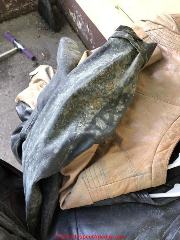 These photos of mold on your clothes (shown here and at the top of this page) look like significant levels of mold contamination, possibly in the Aspergillus group.
These photos of mold on your clothes (shown here and at the top of this page) look like significant levels of mold contamination, possibly in the Aspergillus group.
Of course one can't identify the mold genera/species just from the photo, nor would knowing the mold genera/species change what actions are needed.
Other examples of mold growing on clothing and other fabrics are shown
at MOLD on CLOTHING, CLOTH, BEDDING.
With the sole exception of two species of harmless cosmetic black mold sometimes found on framing lumber there are no indoor molds that should simply be ignores. Such mold growth indoors can be allergenic, toxic, even pathogenic, depending on the specific mold and the surfaces on which it's growing.
See COSMETIC MOLD, RECOGNIZE for more help.
While panic is certainly not justified, exposure to significant levels of indoor mold can sensitize people who previously had no reaction to mold and can be more dangerous for people at extra risk such as the elderly, infants, asthmatics, and people with compromised immune systems such as some cancer patients.
Also it would be rare for only a single genera/species of mold to be present in an area of mold contamination, and if the clothes got moldy while in this location I'd be looking out for mold on or in building walls and ceilings, carpeting, etc.
I would take care to remove this, bag it and if you can't have the clothing successfully cleaned (which is doubtful given the extent of contamination) then it's, unfortunately, probably ready for the trash.
In cases like this I take photos of the items to be thrown-away in case there is possiblity of insurance coverage for part of the loss.
Look further to find where the moisture or water came from as that's what causes mold growth.
Look carefully at other clothing in the same closet - and have it cleaned.
On 2018-09-11 by Lisa lisatroutman60
I don’t know what this is on my clothes [photos shown above] hopefully it’s not contagious.
On 2018-08-25 by (mod) - water stains on wall - hint at mold contamination
Andi:
I don't know what the stains are but it appears you wan to look for a water or leak source.
On 2018-08-25 by Andi
What are these stains on my wall?
On 2018-08-25 by (mod) - dark black and gray mold on window muntins, frames, or vinyl windows
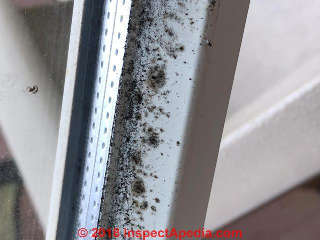 T:
T:
I can't identify the general/species of mold in your window muntin mold photo, nor would knowing that change what you need to do one iota.
Remove the mold by physically cleaning the surfaces.
If you can reduce window condensation that'll help retard its recurrence.
Other examples of mold growth on windows are at MOLD on VINYL WINDOWS.
I see that your window uses double-glazed glass.
Still in some climates in cold weather you may be getting a lot of condensation on the window surfaces, more-so if the window muntis and sash are not well-insulated themselves.
Adding an outdoor storm window would reduce heat loss even through this double-glazed window. Each layer of glazing cuts the rate of heat loss through the window by about 1/3.
Help in reducing the indoor humidity level and thus condensation is
at CONDENSATION on WINDOWS, SKYLIGHTS
On 2018-08-23 by T
Help! What kind of mold is this? [Photo above showing mold on a window muntin].
On 2018-08-14 by (mod) - a hole torn into a wall or ceiling might expose hidden mold, leaks, damage
Sorry but from your photo I don't know what we're looking at.
If there is visible mold, wet insulation, or other signs of leaks, more expert investigation is warranted.
On 2018-08-14 by Upset tenant
What is this? Is it bad besides how it looks?
On 2018-07-04 by (mod) - leak stains hint at hidden mold
I can not see mold in your photo, but I do see leak stains that mean there could indeed be hidden mold growth in the ceiling or wall cavity.
Further investigation to determine the extent of cleanup needed as well as inspection to find and fix the leak source are what's needed.
On 2018-07-11 by Brenda M - are these ceiling stains mold?
I have lived in a 55+gated mobile home community since late March.
The leaks started in May Where the screen porch attached to the home.
Maintenance would come and repair over and over by what he called shoving Styrofoam in there and putting duct tape over it.
Each time the leak would just move a bit. I went out of town for a week 1 June and when I came back maintenance had sprayed kilz and painted saying it had dried out. Within a week to 10 days there was something growing on the ceiling where it had leaked.
It has grown and changed and some even dripped down and splashed on the wall and on my stool underneath. I reported it to the office management.
They were going to have someone come and take care of it but I insisted on having an environmental study. That has now been done however they refuse to let me know what the results are only that they will do a remediation of the water damage.
On 2018-07-04 by (mod) - black tarry stuff not mold
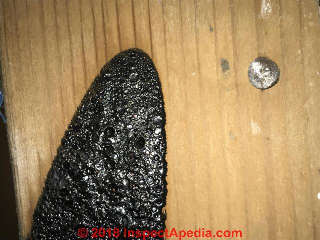 Amber that's a great photo but I can't quite recognize what we are seeing.
Amber that's a great photo but I can't quite recognize what we are seeing.
The nail head gives some scale but please attach a photo from a bit more distant perspective so that I can see the wall cavity, building materials, signs of water entry (if present), and the context of this photo including the base or point of origin of that black material.
This is almost certainly not mold. It looks dense, tarry, shiny and pitted with many small craters of various sizes as would be characteristic of hot tar or hot asphalt mastic or sealant.
I checked with another mycologist (Dr. J.H.) who agreed that this is not like any mold growth we've seen.
Furthermore, the light brown oily stain around the edges of the black ooze is suggestive of a solvent or organic oil that seeped into the wood from the tarry material.
Also there are no surrounding water or dampness marks nor other mold colonies that I'd expect if the wood on which this black stuff is found were in a mold-prone location.
Watch out: this can be an example of a "capture error" in which your attention is captured by something that's not a problem but that in turn diverts you from paying proper attention to important problems such as leaks or mold contamination in your home.
Amber,
- Second, updated comment -
I'm not sure about the black slime in your photos - indeed it could certainly be a fungus, a slime mold or yeast though it looks a bit hard and shiny.
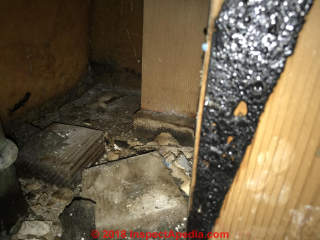 I discussed these photos with Dr. John Haines, a generous and savvy but now retired microscopist who served NY State for many years. John felt that the material probably isn't biological.
I discussed these photos with Dr. John Haines, a generous and savvy but now retired microscopist who served NY State for many years. John felt that the material probably isn't biological.
From the look of it along the stud side I wonder if it's a spill of asphalt mastic - something like that could have occurred even during construction - the builder, knowing the stud isn't affected, simply uses it and sees no reason to clean it off.
If the black goop is rather hard it is probably something like that.
Poke it. If it's soft or smeary we can arrange for you to send a tape sample for pro-bono analysis.
Otherwise my prior comments stand as given below:
In any case identifying the growth (if it is a growth) is not at all necessary to proceed.
Your photo shows an area of trash and debris that is quite apparently sporting a history of being wet. I can't know for sure if this is water entry from outside or a sewage backup, but the area certainly needs to be cleaned and dried, and the source of water entry found and fixed.
The white mass in the second photo lower left looks like it could be wet toilet paper - if so there was a sewage spill or backup in the area.
There could be health risks to people doing the cleaning as well as to building occupants.
If there was a sewer line or drain line leak, then I recommend that you ask for help from a professional sewage cleanup or mold cleanup company and that you ask that the work area be properly isolated from the rest of your home.
In my view some further investigation would be appropriate to find the extent of sewage or water entry that has occurred, as a larger cleanup is likely to be needed.
If there's no sewage there is still a mess of wet materials in the space, some looking moldy and I see what looks like water marks near the bottom of other surfaces in the wall cavity - further investigation / inspection for the extent of damage (and maybe removal of moldy materials) would be appropriate.
Keep us posted about what you are told and what your investigator/cleaning company finds as we may be able to comment further.
On 2018-07-04 by AMBER ZIMMERMAN
Our home is completely covered in surface and airborne molds. Upon moving out I noticed warping at the floor/baseboards of an area that had a large piece of furniture over it.
Curiosity got the best of me and I cut out a portion of the wall to determine if there was hidden mold we had not yet found. I have seen a lot of mold all over the house, but nothing like what is climbing the stud of the wall!!
This is located in the shared wall between the master bedroom and bath.
Can you please help me identify this large slime growing on the studs between the master bedroom and bath?
On 2018-06-21 by (mod) - extensive black mold contamination on plywood roof sheathing
 Paul
Paul
Some countries' states or provinces license mold remediation or cleanup companies, most don't.
There are some professional / marketing associations.
There are also some large franchises that perhaps have standard procedures.
However I'm sorry to say that within any such group I've found a wide range of competence and workmanship. Even working with a company whose results have been excellent in the past, I've seen unfortunate snafus when someone else was acting as crew foreman.
So at the end of the day, get 3 estimates, ask for references, experience, and ask even the most-innocent questions to see if you're getting actual thoughtful content or just arm-waving replies.
It's also my experience that the larger water damage companies have a sales person who closes the deal and someone completely different who supervises the work crew - or doesn't.
Don't make final payment until you're satisfied.
On a large, costly job it makes sense to have at least the clearance inspection and test done by an expert who has absolutely no relationship with the company doing the cleanup.
On 2018-06-21 by Paul
I have spreading garage attic mold that seems general more than spore specific.
I was wondering how to find a reputable company for diagnosis/removal. Is there a professional association?
Thank you very much
On 2018-06-17 by (mod) - fuzzy hairy brown mold growing on OSB
Looks like a form of Stemonitis.
If you search this website for BROWN HAIRY BATHROOM MOLD you'll see more photos and an article about that fungus.
On 2018-06-17 by Bill
What fungi mold is this
On 2018-06-14 2 by Water damage
Ceilings in house dropping wet cold stuff all over is cold and sticky
On 2018-05-31 by (mod) - black mold on painted concrete block foundation wall
Reese
From a blurry black and white photo of dark stuff that looks like mold, it's a bit speculative to claim "toxic" or "allergenic" mold, but most-likely, from the water stains along the floor and on the concrete block wall, yes that's mold growth.
Where there are wet conditions, the mold you see in the photo is not at all likely to be the only mold genera/species in the building, nor should you assume it's the most-harmful.
You need to
remove the mold,
inspect for and remove mold from other surfaces
dispose of mold-contaminated materials that can't be cleaned (insulation, drywall)
find and fix the cause of water entry that made mold grow in the first place
On 2018-05-30 by Reese
Can anyone tell me if this is toxic mold ?
On 2018-05-28 by (mod) - is this "toxic mold"? - Should I "treat it"?
The photo you posted is not clear but I see why looks like mold and water stains.
From the little I can see you need an onside expert who will probably pull off trim and check the wall cavities for the extent of water and mild damage. that should lead to a report giving the scope of Demolition and cleaning and repair needed.
The proper approach to indoor mold contamination is not to "treat" it but to remove it and fix its cause.
On 2018-05-28 by Larry King
Is this black mold? Toxic or not? How should I treat it?
On 2018-04-03 1 by (mod) - mold growth under a kitchen sink and in sink cabinets
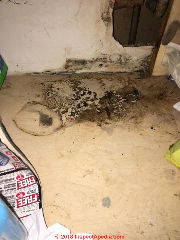 That certainly looks like mold to me.
That certainly looks like mold to me.
Worrying just about "black mold" is a serious mistake.
There are plenty of hazardous indoor molds that are not black and that may be gray, green, white, yellow, orange, blue, brown, etc.
On 2018-03-28 by Sean
The pipe under my sink has been leaking for about 3 years now and today I was getting something out from the cabnet under my sink and noticed this all over the back wall and bottom of my cabinet.
I would realy like to know if this is black mold Incase I need to get it removed.
On 2017-12-15 by Mei
It's so thoughtful of you for giving me a thorough explanation that not only benefit me but anyone who has accessed on your indept research and knowledge about this subject.
After considering your input, I will have to make decision to trash my full-height cabinet tgat has mold growth due to the inter-floor leakage.
I shall go through the cited civil cases for cross-references and litigatuon purposes.
Warmest regards
Mri Tan
P/S: Kindly do not remove this and also my previous inquiries for reference. Thank you very much, danjoefriedman
On 2017-12-12 by (mod) - research & case citations regarding mold contamination & hidden mold
Mei, I'm glad to assist; working together makes us smarter.
About painting over mold, or even laminating drywall over a moldy wall, those approaches are fundamentally incorrect when they leave a large mold reservoir in the building.
It's true that IF the worker could assure that all of the building interior surfaces were perfectly sealed against air and moisture movement in and out of building cavities THEN it might be possible to trap and isolate mold therein.
And IF when sealed those mold colonies were quite dry, and IF no moisture thus entered the cavities, THEN perhaps the risk of continued mold growth that later appears through and out of the covering surface would be low.
So what would remain would be a time bomb waiting to harm future workers or occupants who move into or work in a building presumed to be clean at normal levels.
Here is an example field case:
The owner's daughter grew up in a home I was asked to examine. She had developed acute respiratory distress and mold sensitivity whose origin was unknown. Either chronic exposure or acute exposure to many environmental irritants can cause a person to become hyper-sensitized.
She was so sensitive that if she simply stood at the top of the basement stairs she would begin to have difficulty breathing. It was that report that triggered an investigation.
This photo https://inspectapedia.com/sickhouse/panelingmold.jpg shows what I found.
The photo (from many years ago) shows me pulling away wall paneling to expose a very large mold colony on the drywall surface behind. Mold of several genera was on the drywall, on the hidden side of the paneling, on the cavity side of the drywall, and in the wall cavity.
Some of these molds include species of Aspergillus sp. whose very tiny spores move in the air like a gas and easily ride upwards on building air currents caused by stack effects in buildings.
There was no visible mold on the exposed walls, ceilings, floors, trim, etc. in this space and no one knew this hidden reservoir was present until I pulled open the paneling.
There had been a single event, a sewage backup, twenty years before that had initiated this mold contamination.
Similarly, painting over mold invites mold to continue to flourish as moisture penetrates the paint, and for most paints that mold ultimately pokes its head through the new paint layer.
There is, however, a use for mold sealants and paints after the mold cleanup has been completed. MOLD SANITIZER, SPRAY, BIOCIDE USE GUIDE
Scholars and legal experts have discussed these mold remediation issues, largely as one of legal exposure.
- Fisk, William J., Quanhong Lei‐Gomez, and Mark J. Mendell. "Meta‐analyses of the associations of respiratory health effects with dampness and mold in homes." Indoor air 17, no. 4 (2007): 284-296.
- Henning, Stephen J., and Daniel A. Berman. "Mold contamination: liability and coverage issues: essential information you need to know for successfully handling and resolving any claim involving toxic mold." Hastings W.-Nw. J. Envt'l L. & Pol'y 8 (2001): 73.
- Morey, Philip R. "Mold remediation in North American buildings." In Fundamentals of mold growth in indoor environments and strategies for healthy living, pp. 383-411. Wageningen Academic Publishers, 2011.
- Wu, Felicia, Tom Biksey, and Meryl H. Karol. "Can mold contamination of homes be regulated? Lessons learned from radon and lead policies." (2007): 4861-4867.
- Weisse Guenter K "Process for inhibiting microbial growth in water-based paints." U.S. Patent 3,892,699, issued July 1, 1975. Assigned to Olin Paints.
Watch out: NONE of these warnings mean that anyone should panic about mold contamination in buildings. There is airborne mold everywhere, all the time. Small amounts of indoor mold growth can be readily dealt with as an ordinary household cleaning project or a small handyman project.
And occasionally people mistake COSMETIC MOLD for harmful mold (search InspectApedia.com for that term) where actually no action is needed to protect health.
However when there is a large indoor mold reservoir (more than 30 sq.ft. of contiguous mold), there can be serious health risks, particularly for people who are asthmatic, allergic, immune impaired, elderly, infant, or otherwise at risk. More-expert help is needed to
- find the mold reservoir(s) in the building -
see MOLD APPEARANCE - WHAT MOLD LOOKS LIKE
and also see HIDDEN MOLD, HOW TO FIND and
lso see MOLD INVESTIGATION PROCEDURE TIPS
- define the scope of cleanup
- define the cause of the mold contamination
- remove the mold, clean the surfaces, fix the leaks, then restore the building
- MOLD CLEANUP GUIDE- HOW TO GET RID OF MOLD
On 2017-12-12 by (mod) - advice on cleaning up or removing mold
Mei
You will find a series of guides for mold clean-up procedures in INDEX to RELATED ARTICLES at our Continue reading suggestions at the end of this article.
I want you to add that in that same ARTICLE INDEX you will find an article titled humidity level Target that you want to review
efflorescence is a mineral salt that's left behind when water has passed through material usually Masonry, leaving crystalline debris. It's not a biological material and it doesn't spread through the air.
On 2017-12-11 by Mei
1) Need further understanding what type of physical cleaning requirement in dampness indoor unit surfacess of between 17% - 39%.
2) If efflorescence were assumed to be found, would it easily spread to other rooms before preventive treatmrnt could be applied pending total dryness on ceiling and walls?
3) how do we know what % dampness is sustainable for mold growth activity to take place?
Hope to hv your explanation for safety neighbourhood dwelling consciousness.
Any civil case could we refer to when we have to make an understanding or debating that mold cleaning is really mandatory prior paint work.
Appreciate and valued your action plan recommendation to point out the right direction on inter floor leakage seriousness and thoroughness for a safe and long term property environment.
Hence, mold inspection and remedial proposal cant be avoided. Got it and thank you for all info rendered to us.
Warmest regards
Mei
On 2017-12-04 by (mod) - photo of many small black spots on wall looks like mold
Mei,
Your photo of many black spots on a wall is too blurry to know for sure what it is but it certainly looks like mold.
It is never a proper nor effective mold remediation plan for simply paint over mold.
First of all there may be a worse problem inside of the wall or ceiling that's being painted.
Second, the cause for the mold growth needs to be identified and corrected.
On 2017-12-04 by Mei - are these photos showing mold?
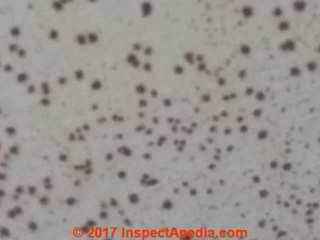 Im not sure if you kindly comment on Mei's 3 images per my comments below.
Im not sure if you kindly comment on Mei's 3 images per my comments below.
The recommendation was to apply encapsulation method to make good affected area of dry ceiling and wall. Is this the best method for application on these patches? Also is it effective to remove musky smell in my house?
To add in, the management does not think a need for mold cleaning but just pull over 1 coat paint.
As this place is on lower floor sunlight is little coming into this room. The living hall would have a little more sunlight in the day time.
Appreciate your expert advice for a safe remedial solution towards halthy living.
Appreciated so much for your contibution.
Mei
3rd image - above
2nd image.... [too blurry to comment - Editor]
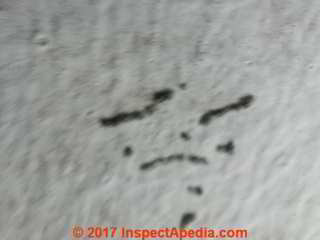 Attached images were just taken fm mobile (not sure visual sharp) Wonder what these spots are called.
Attached images were just taken fm mobile (not sure visual sharp) Wonder what these spots are called.
Upon observation, patches become prominent seen since after 10nov17 especially on living hall and 2nd room.
This is high-rise apartment and im on low level and seldom sun light shines through this 2nd room.
This room has 2 windows to increase ventilation. Would evaporation takes place if left windows ajar?
Recommendation was to apply encapsulation method to make good affected area of dry ceiling and wall. Is this the best method for application on these patches?
Also is it effective to remove musky smell in my house?
Appreciate your expert advice for a safe remedial solution.
On 2017-12-04 by (mod) - Kevin's attic mold?
In some of your photos I see what looks like older darker rafters and roof sheathing with some lighter rafters and sheathing in the foreground. That actually looks as if some roofing materials were replaced at some point.
The white marks on rafters in foreground could be mold growth but do not extend over onto abutting surfaces - suggesting that whatever it is it's not going on in the attic itself.
The amber droplets in your last photo are wood sap.
it looks to me as if there is mold on those surfaces and it also looks as if there may have been water leaks. If water has entered a wall or floor cavity there may be additional mold that's hidden that we will need to address.
If there were no leaks into the building cavities then it certainly is reasonable to clean and seal the surfaces that are moldy. of course we need to find and fix the source of water as well
On 2017-12-04 by Kevin
 Prompted by your comment, I went up and double-checked.
Prompted by your comment, I went up and double-checked.
There are a couple of places where there are "spots" on neighboring pieces of wood, but never one "spot" than spans two pieces of wood.
There are numerous places, though, where the "spots" are very heavily concentrated on one piece and then break off right at the place where it connects to another piece.
I've included a picture which shows the way it stops at a joint and hopefully also gives a better view of the substance in question (along with the lovely attic sap). I'm inclined to err on the side of caution and have it removed anyway.
On 2017-12-03 by (mod) -
That does begin to sound more like mold
On 2017-12-02 by Kevin
Thanks. I can't be sure it wasn't there, but I'll go with a tape sample. There are places where it's isolated, but then a few places (you can see one in the top left corner of the picture) where it's on two pieces of wood.
On 2017-12-02 by (mod) -
If you are absolutely convinced that that material was not on that piece of wood until recently, and if nothing has been spilled or splashed to leave such deposits on that particular piece of wood, it could be mold. I can't really tell from the photograph.
It is however unusual for mold to grow on just one piece of wood where there are two abutting similar wood surfaces.
Swab sampling for mold is innately unreliable both because it destroys the structures we would like to see in the microscope and because if the swab relies on using it on a culture plate , we run into the problem that only 10% of all molds will grow in any culture media whatsoever.
A better test method would be to collect a surface tape sample and send it to a mold testing lab.
Also, even though Aspergillus/Penicillium are common airborne molds they are in outdoor air usually at low levels. We do not normally find more than incidental occurrences of those spores on indoor building surfaces unless there is a mold colony nearby.
On 2017-12-02 by Kevin
 Thanks for all the information on this site! I noticed "something" in the attic a couple of weeks ago that looked to me like mold.
Thanks for all the information on this site! I noticed "something" in the attic a couple of weeks ago that looked to me like mold.
That's in the picture (which I've tried to attach); there's a similar spot on another piece of wood and similar, if smaller, stains along the ridge line and on some of the baffles, but those I wouldn't necessarily notice.
One mold inspector, who doesn't do repairs, thought it was mold; he took a surface test, using a swab, which found only scattered spores [1-20 fungal spores] of aspergillus/pennicillium (common outdoors here in central Virginia) and no fungal growth. Another mold inspector, who DOES do repairs, doubts it is mold:
He thinks it's drywall mud that has been there for years; he said it's powdery and spreads when you rub it (which I know you raise doubts about), and that it smells like drywall mud and not mold.
[Click to enlarge any image]
Although it's been a humid 18 months or so, we have no signs of water damage. However, I can't imagine that I've never noticed a stain this big in the seven-plus years we've lived in the house. If you have any thoughts or guesses, or suggestions for determining whether it's mold, I would appreciate them.
My plan is to have it cleaned--we have to have work done in the crawl space, where it is clearly mold--but if it is mold, I want to look into taking steps to prevent it coming back.
It looks enough like this picture (https://inspectapedia.com/sickhouse/atticmolds.jpg
and https://inspectapedia.com/sickhouse/atticmoldDF3.jpg) that I'm concerned. Thank you so much!
On 2017-12-02 by (mod) - building manager says these black spots are not mold
If water leaked into a drywall ceiling that was left in place mold contamination on the ceiling is highly likely
What you see may be the tip of the iceberg.
Looking at your photos (below) I see what is unquestionably dark spots of mold. There may also be some mineral effloesence, or that could be a white fungs. Even if the white material is efflorescence (possible if the wall behind is masonry) that's evidence of a leak or moisture problem that can generate mold elsewhere.
On 2017-12-02 by Mei
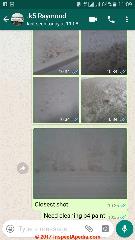 Recently my house was affected by stains patches problems due to upper apartment kitchen tap pipe burst with polluted water stagnant overtime. The upper house has no occupancy throughout the year as the owner works abroad and stays here on leave break.
Recently my house was affected by stains patches problems due to upper apartment kitchen tap pipe burst with polluted water stagnant overtime. The upper house has no occupancy throughout the year as the owner works abroad and stays here on leave break.
[Click to enlarge any image]
The dirty water stagnant was not immediately realised till I, the owner of the below unit, spotted damp patches on parts of my unit ceiling and walls.
As of writing to you, the unit above rectification works has been done 2-week ago. My unit case is an inter-floor leakage and pending rectification works at mu unit.
The Building Manager said the black spots are not molds on my unit ceiling and walls. I wonder if you have an advice how I could get frienfly assistance that the circles images could be identified as black or brown mold growth related.Mold
On 2017-12-01 by (mod) -
Tom, all of the materials you describe could certainly be moldy. There is no mildew in buildings. Mildew is an obligate parasite form of mold that grows only on living plants. But I acknowledge that many people speak more carelessly and use the terms interchangably, though improperly.
On 2017-10-28 by Tom
Question: I noticed what looked like moisture damage to a couple spots on my first floor hard wood floors. I went into the crawl space and peeled back the fiberglass insulation in these areas. The insulation paper facing the sub floor is black and peeling.
The sub floor is stained slightly black and slightly damp, but not wet. There are no pipes or anything here to cause condensation. The insulation paper almost has a burnt appearance (obviously it’s not ). Does anyone have any thoughts? Mold or mildew?
On 2017-10-16 by Christine
I live In a split level home, and on the lower lever (not the basement) I kept on smelling musty/MOLD, but no one else did in my family. Finally we all got sick and I made them get down and smell! Well, we pulled up all of the carpet, all the padding, scrapped the floor, and repainted it.
I STILL SMELL THE MOLD AND NO ON ELSE DOES!
I wiped down all the walls because we are getting ready to paint them, but the smell is the strongest on the walls we have not started to paint yet--I have only lived here a little over 2 years and I know my boyfriend will not go to kindly if I start cutting holes in the walls because the carpet cost us over $2,000!
I do not know if I am going crazy with smelling the mold all the time but it is making me sick--I have asthma and real bad migraines. HELP how do I get rid of this smell!!
On 2017-09-03 by Keith
We have what looks like mild spores visible from the basement on the plywood subfloor between the joist. This is a new build and the exposed side of the plywood was sealed with Thompsons water seal while the house was being built. How should we treat this?
On 2017-09-01 by (mod) -
Sharon
A pile of dark dirt or powder wouldn't be just a pile of mold spores, but it could be a fungal growth including the fruiting body, mycelia and other fungal materials that produce spores. Take a look at my photo of Stemonitis growing on a wood subfloor
https://inspectapedia.com/mold/Brown_Mold905-DJFs.jpg
On 2017-09-01 by Sharon
Watching a friends home and found they have pile of what looks like dark dirt, baby powder soft in a corner of room. Could it be mold spores?
On 2017-08-31 by (mod) -
Carolina
You should not have to sand off moldy surfaces. If you suspect it's mold and simply use any household cleaner and a few paper towels to clean up the wood framing you describe that's normally enough for small cleanup jobs (under 30 sq.ft.)
If the area is wet or humid or subject to leaks then you want those fixed to avoid a mold problem.
Beyond that advice I can't guess as I can't see your black specks. You can use the page bottom CONTACT link to send a photo if you like, and I may be able to comment further.
Also take a look at our description of black cosmetic mold by searching InspectApedia for BLACK COSMETIC MOLD to see what that looks-like.
On 2017-08-30 by carolinagirlac1982
I have black specks on some of wood rafters in basement I am worried it's mold. When I spray it it kinda spreads and comes off best when use sandpaper
On 2017-05-03 by Vicki
The inside of the unfinished wood door in our boiler/hot water heater closet has black stains (hundreds of spots) all over the bottom of it and then sporadically a few spots until about midway up the door. The stains appear to be embedded in the wood and follow the grains of the wood.
There is no fuzziness to them at all. The boiler was an oil burning system until about 4 years ago when we converted to natural gas. I honestly have no idea if the door looked like that when we bought the house 5.5 years ago or if it's something new.
Could this be mold? I scrubbed the door with a bleach/water solution with a scrub brush but it does not come off, even after scrubbing so hard that the top layer of wood looks like it was sanded down. Could this possibly be some sort of oil staining or something else?
On 2017-04-12 by (mod) -
There could be many molds that meet your description; a lot depends on on growth environment, temperature, moisture, and growth material. Search Inspectapedia for STEMONITIS on PLYWOOD for some examples.
On 2017-04-09 by Anonymous
What mold is amber in color and looks kinda like moss or hair
On 2016-12-08 by (mod) -
Angel:
Your statements on mold growth time are not accurate. Mold can appear on building surfaces in 24-48 hours in the right conditions. Please search InspectApedia.com for AGE OF MOLD to read details.
On 2016-12-08 by (mod) -
"Stachybotrys chartarum (SC) is a greenish black mold that is found throughout the world and is typically wet and slimy to the touch.Stachybotrys survives a wide variation in temperature and grows most proficiently in temperatures that humans consider warm to moderately hot. It tends to develop more slowly than many other molds-
ONE TO TWO WEEKS after moisture intrusion as compared to one to two days for molds like aspergillus, penicillium, or cladosporium. Despite its slow start, stachybotrys usually develops into the dominant mold if the conditions are favorable, eventually crowding out other mold types that may have colonized the material first.
“It grows VIGOROUSLY where moisture has accumulated from roof or wall leaks, or chronically wet areas from plumbing leaks. It is often hidden within the building envelope.”
On 2016-12-08 by Angel
Angel said:
It takes one to two weeks for black mold to start growing under damp, wet conditions.
How long it takes to grow 1 to 2 ft up a wall ...depends on the room's temperature, moisture/humidity, type of material it's growing on (plaster, wood, cement etc) & if other types of mold spores were already on the wall & ceiling's surface.
" After a single incident of water damage occurs in a building, molds grow inside walls and then become dormant until a subsequent incident of high humidity; this illustrates how mold can appear to be a sudden problem, long after a previous flood or water incident that did not produce a mold-related problem.
The right conditions re-activate mold. Studies also show that mycotoxin levels are perceptibly higher in buildings that have once had a water incident (source CMHC)."
...
Continue reading at MOLD APPEARANCE - WHAT MOLD LOOKS LIKE - topic home, or select a topic from the closely-related articles below, or see the complete ARTICLE INDEX.
Or see
Recommended Articles
- MOLD APPEARANCE - STUFF THAT IS NOT MOLD
- MOLD APPEARANCE on VARIOUS SURFACES photo guide to what mold looks like growing on more than 100 different building surfaces
- MOLD APPEARANCE - WHAT MOLD LOOKS LIKE - what toxic black mold or other indoor mold looks like in buildings.
- BLACK MOLD IDENTIFICATION
- BLACK MOLD, HARMLESS
- BROWN MOLD PHOTOS
- COSMETIC MOLD, RECOGNIZE
- GREEN MOLD PHOTOS
- INVISIBLE MOLD
- LIGHT COLORED MOLD
- MERULIPORIA HOUSE EATING FUNGUS
- MERULIPORIA FUNGUS & TERMITE INTERACTIONS
- PORIA DAMAGE PREVENTION
- MILDEW ERRORS, IT's MOLD
- MILDEW PHOTOGRAPHS
- MOLD ATLAS & PARTICLES INDEX
- MOLD on DIRT FLOORS
- MOLD GROWTH on SURFACES, PHOTOS catalog of images of mold growth on various materials & surfaces
- MOLD GROWTH on SURFACES, TABLE OF a Table of Kinds of Mold Growth Found on Building Surfaces
- MOLD by MICROSCOPE Photo ID Library for detection and identification of toxic or other mold
- MOLD in the PETRI DISH, PHOTOS Photo s of Mold Growing on Petri Dishes, Mold Culture Plate, Settlement Plates
- RED MOLD PHOTOS
- YELLOW MOLD PHOTOS
- WHITE MOLD PHOTOS
- MOLD ATLAS & PARTICLES INDEX atlas of building molds and microphotographs of mold samples observed in the laboratory
- MOLD RELATED ILLNESS SYMPTOMS Index of Symptoms
- STAINS on & in BUILDINGS, CAUSES & CURES
Suggested citation for this web page
MOLD APPEARANCE FAQs-3 at InspectApedia.com - online encyclopedia of building & environmental inspection, testing, diagnosis, repair, & problem prevention advice.
Or see this
INDEX to RELATED ARTICLES: ARTICLE INDEX to MOLD CONTAMINATION & REMEDIATION
Or use the SEARCH BOX found below to Ask a Question or Search InspectApedia
Ask a Question or Search InspectApedia
Try the search box just below, or if you prefer, post a question or comment in the Comments box below and we will respond promptly.
Search the InspectApedia website
Note: appearance of your Comment below may be delayed: if your comment contains an image, photograph, web link, or text that looks to the software as if it might be a web link, your posting will appear after it has been approved by a moderator. Apologies for the delay.
Only one image can be added per comment but you can post as many comments, and therefore images, as you like.
You will not receive a notification when a response to your question has been posted.
Please bookmark this page to make it easy for you to check back for our response.
Our Comment Box is provided by Countable Web Productions countable.ca
Citations & References
In addition to any citations in the article above, a full list is available on request.
- In addition to citations & references found in this article, see the research citations given at the end of the related articles found at our suggested
CONTINUE READING or RECOMMENDED ARTICLES.
- Carson, Dunlop & Associates Ltd., 120 Carlton Street Suite 407, Toronto ON M5A 4K2. Tel: (416) 964-9415 1-800-268-7070 Email: info@carsondunlop.com. Alan Carson is a past president of ASHI, the American Society of Home Inspectors.
Thanks to Alan Carson and Bob Dunlop, for permission for InspectAPedia to use text excerpts from The HOME REFERENCE BOOK - the Encyclopedia of Homes and to use illustrations from The ILLUSTRATED HOME .
Carson Dunlop Associates provides extensive home inspection education and report writing material. In gratitude we provide links to tsome Carson Dunlop Associates products and services.


